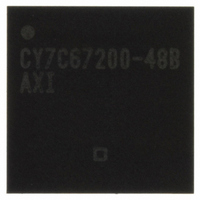CY7C67200-48BAXI Cypress Semiconductor Corp, CY7C67200-48BAXI Datasheet - Page 7

CY7C67200-48BAXI
Manufacturer Part Number
CY7C67200-48BAXI
Description
USB HOST/PERIPH CNTRLR 48LFBGA
Manufacturer
Cypress Semiconductor Corp
Series
EZ-OTG™r
Type
OTG Programmable USB On The Gor
Datasheet
1.CY7C67200-48BAXI.pdf
(78 pages)
Specifications of CY7C67200-48BAXI
Package / Case
48-LFBGA
Controller Type
USB Peripheral Controller
Interface
Serial
Voltage - Supply
2.7 V ~ 3.6 V, 3 V ~ 3.6 V
Current - Supply
80mA, 135mA
Operating Temperature
-40°C ~ 85°C
Mounting Type
Surface Mount
Data Rate
2 Mbps
Maximum Operating Temperature
+ 85 C
Minimum Operating Temperature
- 40 C
Mounting Style
SMD/SMT
Operating Temperature Range
- 40 C to + 85 C
Supply Current
80 mA
Supply Voltage (max)
3.6 V
Supply Voltage (min)
2.7 V
Operating Supply Voltage
2.7 V to 3.6 V
Controller Family/series
PSoC 1
Core Size
16 Bit
No. Of I/o's
25
Program Memory Size
16KB
Ram Memory Size
8KB
Cpu Speed
48MHz
No. Of Timers
2
Rohs Compliant
Yes
Lead Free Status / RoHS Status
Lead free / RoHS Compliant
For Use With
CY3663 - KIT DEV EZ-OTG/EZ-HOST
Lead Free Status / Rohs Status
Lead free / RoHS Compliant
Other names
428-2262
CY7C67200-48BAXI
CY7C67200-48BAXI
Available stocks
Company
Part Number
Manufacturer
Quantity
Price
Company:
Part Number:
CY7C67200-48BAXI
Manufacturer:
CYPRESS
Quantity:
1 500
Company:
Part Number:
CY7C67200-48BAXI
Manufacturer:
CY
Quantity:
6
Company:
Part Number:
CY7C67200-48BAXI
Manufacturer:
Cypress Semiconductor Corp
Quantity:
10 000
Part Number:
CY7C67200-48BAXI
Manufacturer:
CYPRESS/赛普拉斯
Quantity:
20 000
Company:
Part Number:
CY7C67200-48BAXIT
Manufacturer:
XAC
Quantity:
105
Company:
Part Number:
CY7C67200-48BAXIT
Manufacturer:
Cypress Semiconductor Corp
Quantity:
10 000
Part Number:
CY7C67200-48BAXIT
Manufacturer:
CYPRESS/赛普拉斯
Quantity:
20 000
Document #: 38-08014 Rev. *G
Crystal Pins
Table 13.Crystal Pins
Boot Configuration Interface
EZ-OTG can boot into any one of four modes. The mode it
boots into is determined by the TTL voltage level of
GPIO[31:30] at the time nRESET is deasserted.
shows the different boot pin combinations possible. After a
reset pin event occurs, the BIOS bootup procedure executes
for up to 3 ms. GPIO[31:30] are sampled by the BIOS during
bootup only. After bootup these pins are available to the appli-
cation as GPIOs.
Table 14.Boot Configuration Interface
GPIO[31:30] must be pulled high or low, as needed, using
resistors tied to V
ohm and 15K ohm. GPIO[31:30] must not be tied directly to
V
those two pins are used for the serial I2C EEPROM (if imple-
mented). The resistors used for these pull ups must conform
to the serial EEPROM manufacturer's requirements.
If any mode other then standalone is chosen, EZ-OTG will be
in coprocessor mode. The device will power up with the appro-
priate communication interface enabled according to its boot
pins and wait idle until a coprocessor communicates with it.
See the BIOS documentation for greater detail on the boot
process.
XTALIN
XTALOUT
GPIO31
(Pin 39)
CC
0
0
1
1
or GND. Note that in Standalone mode, the pull ups on
Pin Name
GPIO30
(Pin 40)
0
1
0
1
CC
or GND with resistor values between 5K
Host Port Interface (HPI)
High Speed Serial (HSS)
Serial Peripheral Interface (SPI, slave
mode)
I2C EEPROM (Standalone Mode)
Boot Mode
Pin Number
G3
G2
Table 14
Operational Modes
There are two modes of operation: Coprocessor and
Standalone.
Coprocessor Mode
EZ-OTG can act as a coprocessor to an external host
processor. In this mode, an external host processor drives
EZ-OTG and is the main processor rather then EZ-OTG’s own
16-bit internal CPU. An external host processor may interface
to EZ-OTG through one of the following three interfaces in
coprocessor mode:
At bootup GPIO[31:30] determine which of these three inter-
faces are used for coprocessor mode. Refer to
details. Bootloading begins from the selected interface after
POR + 3 ms of BIOS bootup.
Standalone Mode
In standalone mode, there is no external processor connected
to EZ-OTG. Instead, EZ-OTG’s own internal 16-bit CPU is the
main processor and firmware is typically downloaded from an
EEPROM. Optionally, firmware may also be downloaded via
USB. Refer to
After booting into standalone mode (GPIO[31:30] = ‘11’), the
following pins are affected:
• HPI mode, a 16-bit parallel interface with up to 16 MBytes
• HSS mode, a serial interface with up to 2M baud transfer
• SPI mode, a serial interface with up to 2 Mbits/s transfer
• GPIO[31:30] are configured as output pins to examine the
• GPIO[28:27] are enabled for debug UART mode.
• GPIO[29] is configured as OTGID for OTG applications on
• Ports 1B, 2A, and 2B default as USB peripheral ports.
• All other pins remain INPUT pins.
transfer rate
rate
rate.
EEPROM contents.
PORT1A.
— If OTGID is logic 1 then PORT1A (OTG) is configured
— If OTGID is logic 0 then PORT1A (OTG) is configured
as a USB peripheral.
as a USB host.
Table 14
for booting into standalone mode.
CY7C67200
Page 7 of 78
Table 14
for
[+] Feedback












